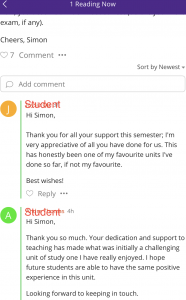Dr Simon Kwok holds a PhD from Cornell University and specialises in time series econometrics and finance: ‘essentially a study of how observations align over time, like the stock prices over time or inflation rates over time and trying to build up mathematical models explain their evolution and their variation’. Simon is also a passionate teacher in the School of Economics and recently we chatted about how he discovered economics as his discipline, some of the big challenges the School of Economics has faced over the last two years and how he has adapted, and how to engage students when teaching difficult content in challenging circumstances.
Leanne Stevenson: How did you become interested in economics?
Simon Kwok: I’ve been interested in numbers and mathematics since high school and in the last year of my undergraduate degree in statistics and actuarial studies I started to think about what I wanted to do after graduation, that big question, so I decided to give myself more time by diving into a research master’s degree. My supervisor was working on economic time series analysis, and I was interested in both that and their preferences on how to choose research topics. I’d made up my mind not to work in industry and to instead go into academic research because I wanted to dig into the real reasoning behind how things work, how we observe economic phenomena in the real world. I wanted to study rather than just blindly accept a reality, and became determined to do a PhD.

Leanne: What have been the big challenges in your school over the last few years? What has changed and what helps to adjust to change?
Simon: I joined Economics after it moved from the Business School into the Faculty of Arts and Social Sciences – I was in the first batch of new hires and the school has kept growing since then. Surprisingly, the number of students in the program has doubled during the height of COVID. A medium-sized class is 200- or 300-plus students now, and big units can easily exceed 1000 students. Some of that is because we’ve leveraged being able to deliver lectures on Zoom, and combined some units that were once offered in parallel.
So, more (and effective) resources have become a crucial part of our day-to-day teaching. Marking assignments, exam grading, student engagement, these are things that require additional people power; tutors and helpers in classes who do administrative work and also hold consultation hours. These extra resources requested were generously approved by our Head of School. The other thing that comes to our rescue is technology; utilising platforms such as ED Discussion forums has been huge and as a bonus it was designed by one of our alumni! Also
using SRES, I write tailormade emails for students depending on their grades in the midterm exam. Students are appreciative of the warmth and also the individualised feedback which they otherwise perhaps wouldn’t expect to receive in such big units.
SRES is a great platform, but academics have to invest time in the training and make that first attempt to implement it in class, which can be a hurdle. Colleagues who know SRES well or who are student engagement professionals could be helpful in this space, as learning the system takes effort and investment. Administrative support is something that academic staff always appreciate.
Leanne: I’ve always thought, because complex math is like a foreign language to me, that economics must be very hard to study. Do students find it hard?
Simon: Economics is mathematics because we really need an exact language to describe what’s going on behind economic models, or inflation rates, or GDP growth and this requires a precise description. It this can be quite a technical degree but it’s also not purely mathematics, because we need to consider the human dimension, the psychological, which complicates how economic systems will work. It’s a combination between, on one hand, the exact language of mathematics, and, on the other hand, the human dimension from social sciences. It can be quite challenging for many students, especially for those who struggle with quantitative skills and analysis.
Leanne: So how do you engage students in the classroom, how do you ask students to want to learn difficult material and be enthusiastic about it?
Simon: It can be really challenging. On Zoom, I can’t use breakout rooms with 200 or 300 students because the chances that one room would be in dead silence are pretty high. When I lecture, I try and keep their attention by handwriting – I invested in a stylus pen and pad to write on which is attached to my laptop, so I write with colourful pens to keep students engaged in the lecture. I also invite my tutor to join my lecture (which they are, of course, paid for) as well, so that they can monitor the Zoom chat, and perhaps ask a question or remind students of an important point I mentioned. This initiates further conversation in the chat box.
In my smaller unit of 120 students, I’ve built further engagement into the assessment structure. These students are assigned group presentations, and over the past two years have completed them by making a YouTube video that they post in our discussion forum. I encourage healthy competition among the groups, for example, by asking students to challenge the other groups, asking questions and leaving comments. I encourage students to give likes, so they compete with each other for the most likes and number of comments, and I give bonus marks to those groups with the most likes. This has turned out to be a successful tactic in creating more traffic in the discussion forum across the semester, which otherwise would be dead at times other than when the assessment is due.
I’ve heard from past students that they have showcased this YouTube presentation in an interview, which eventually led to a job offer. It’s a strong and very tangible piece of evidence for them to show their potential employers which couldn’t have happened in the old days of in-class presentations.

Leanne: I’ve also heard you have a special way to personalise assessments?
Simon: I have a little practice of introducing my family members as important people in my exam papers. Within a particular context, my dog, my cat, my wife’s name, or my son’s name and then I use them as personae in economic scenarios. This creates a funny linkage because I talk about them in my lectures, so the students feel like they know them well. I bumped into a student one day at the Easter Show, after I heard someone calling out my name and my son’s name. They recognised our faces because I posted our photos in a discussion, and they said; “I’m your student and I got 38 out of 40 on the midterm exam. Do you remember me?”.
I didn’t recognise the student because there are so many faces on zoom, but I do love those kinds of encounters in real life.
Want to know more?
- Come along to an upcoming SRES workshop. These are generally scheduled towards the start of each semester.
Other recent Teaching@Sydney articles in this series
- ‘It’s the pedagogy not the technology that counts’ in HyFlex teaching
- Well-being first: Building relationships in online teaching spaces
- In the Margins: Creating Cultural Change in the Faculty of Arts and Social Sciences
- “This is not business as usual”: Belonging in the teaching team
- Continuity and Change: Teaching history via material culture in the 21st Century





